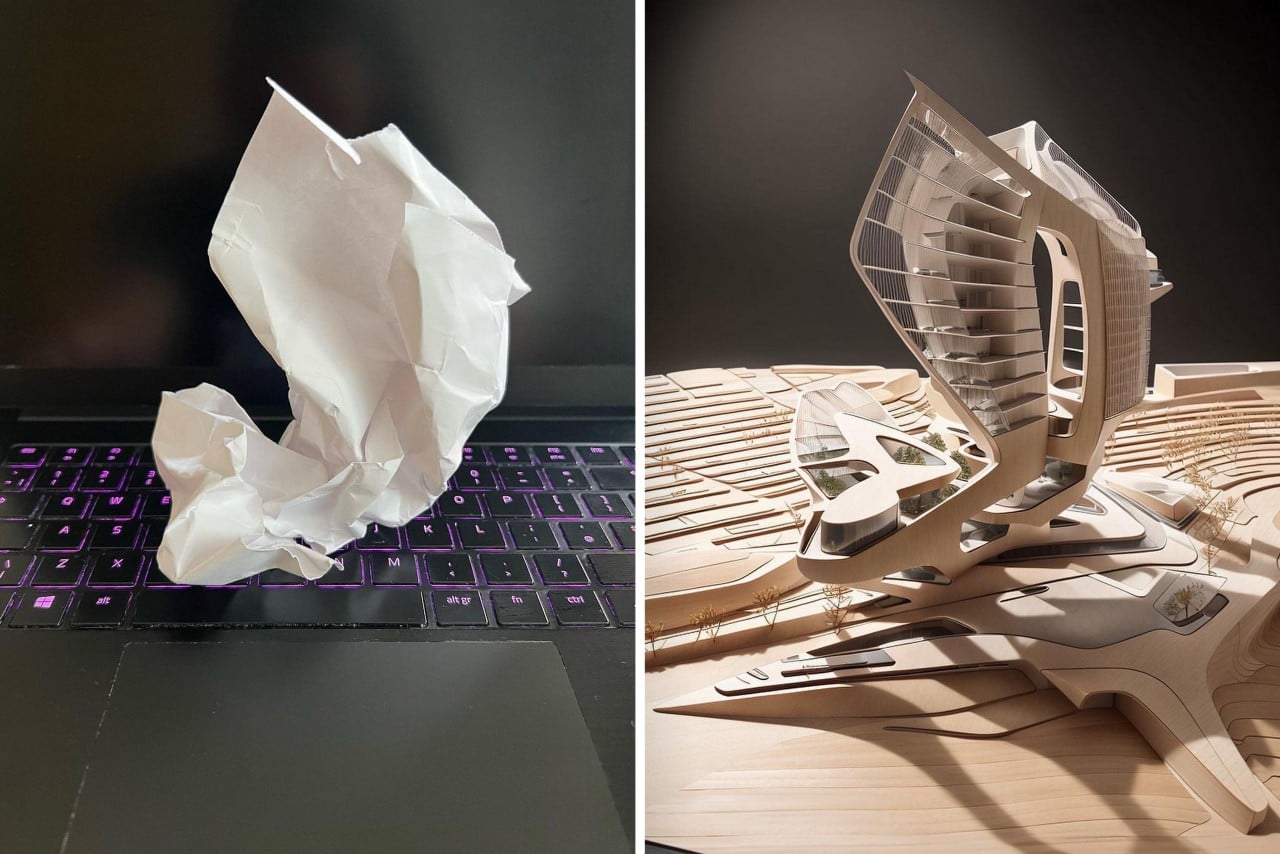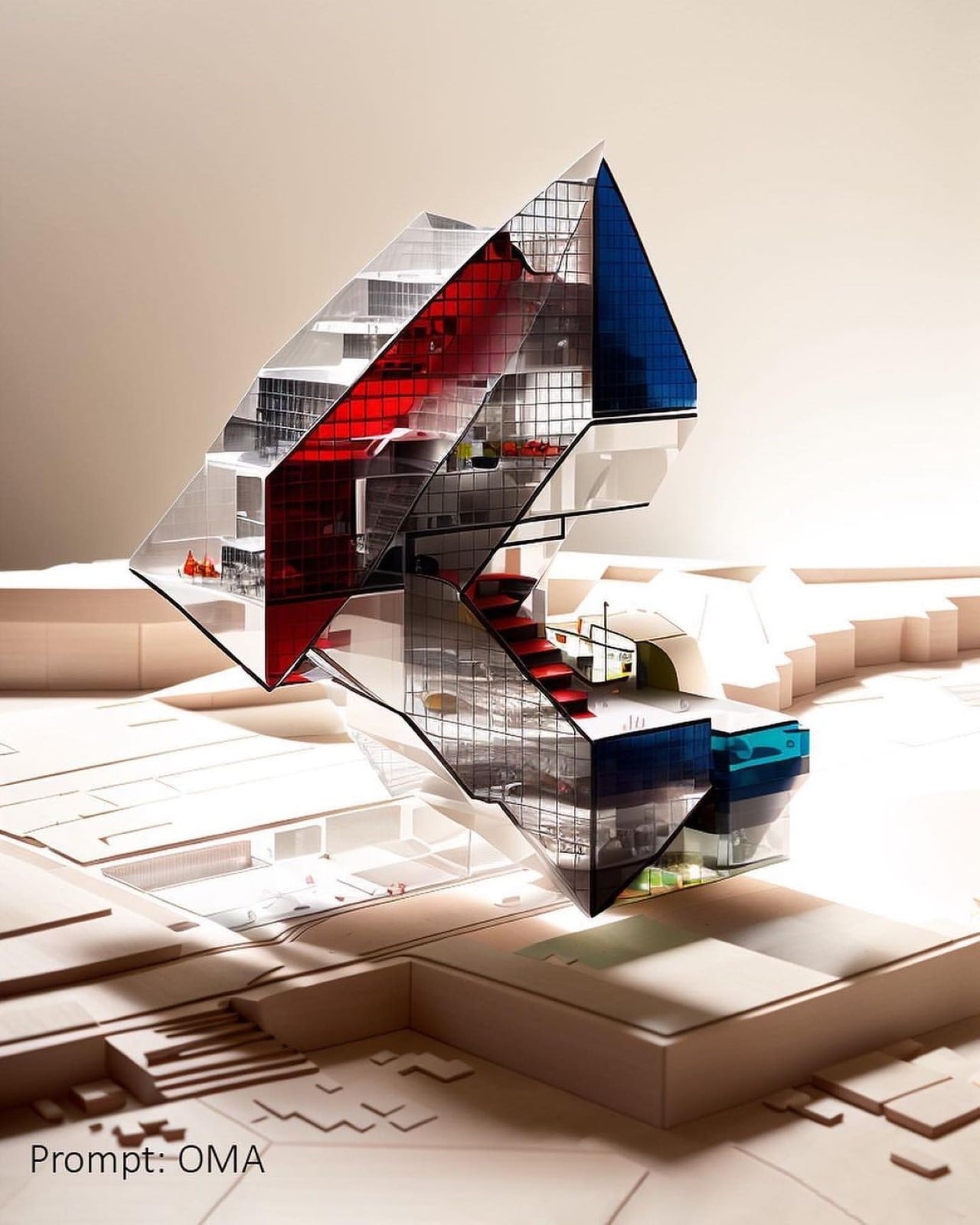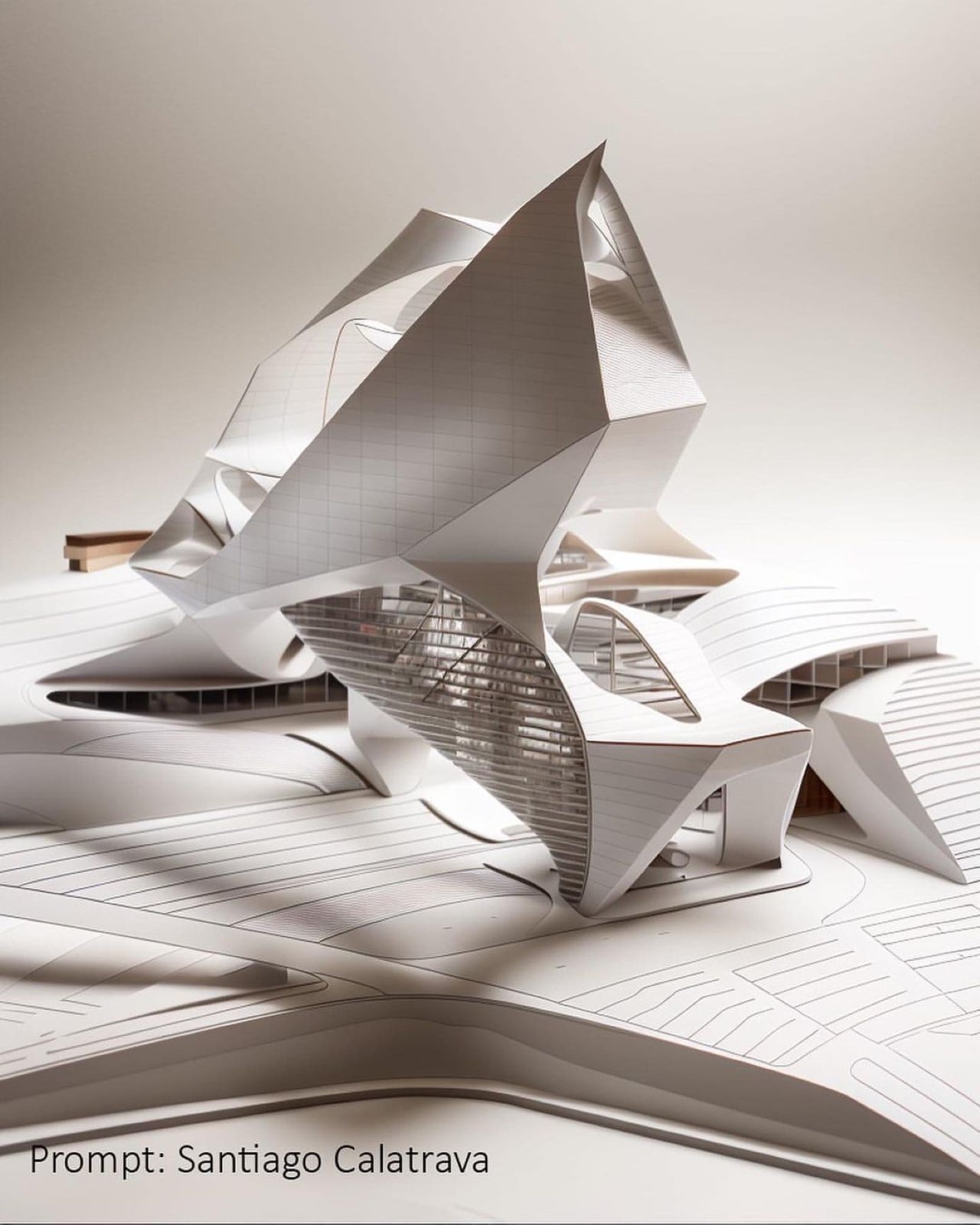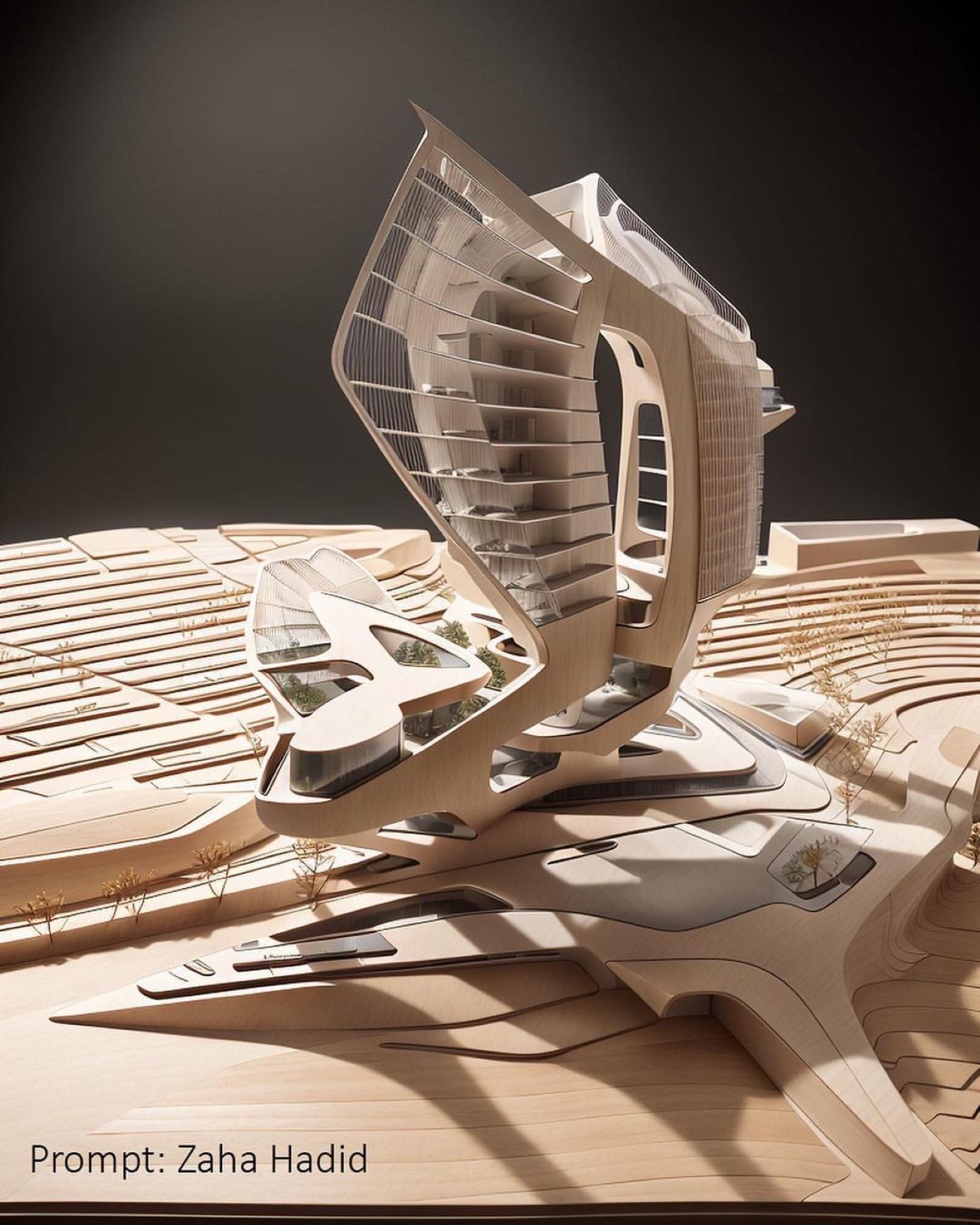
AI may not steal our jobs, however it for certain will assist us grow to be MUCH extra gifted. Instruments like Midjourney assist push our creativity to new heights by permitting us to think about virtually something. Some artists have used it to think about sapphire-crusted gold thrones, others have turned luxurious cars into high-octane off-roaders, and architect Tim Fu is utilizing Midjourney to comprehend giant architectural marvels by utilizing one thing as uncommon as crumpled paper as his supply of inspiration.
Merely dubbed “Crumpled Paper Structure”, this collection explores Midjourney’s Picture to Picture function. All you do is add a picture, add an outline or immediate, and the AI works utilizing each as an enter. Tim’s prompts featured names of distinguished architectures, and the AI did the remaining, turning the haphazard folds within the paper into architectural particulars. The outcomes are incredible, however extra so, they open up new potentialities for ideation. Designers and designers can now look wherever for inspiration, and depend on an AI to carry their visions to life… In any case, if crumpled paper can look this good!
Designer: Tim Fu (by way of Midjourney)

The picture above served as Tim’s supply file, which the AI took as a visible enter. Tim merely crumpled a chunk of high-GSM paper (for extra detailed folds) advert positioned it on his keyboard as a base. The keys of the keyboard acted as a neat perspective information for the AI, serving to it perceive scale, peak, perspective, and so on.
The second a part of the train was to provide the AI a immediate, instructing it to govern the picture within the type of your selecting. Under is an instance of the AI harnessing the type of Pritzker-prize-winning architectural agency SANAA (Sejima And Nishizawa And Associates). Impressed by the structure of the Sydney Trendy Museum and the Flats on Ave. Maréchal Fayolle in Paris, the AI created a multi-level constructing with curved, undulating facades in white. The curved structure goals at creating dynamic areas on the within in addition to an exterior that advantages properly from direct daylight, creating a singular interaction between highlights and shadows.

A immediate to show the paper into the structure of Zaha Hadid yielded some attention-grabbing outcomes too. The late architect’s works discover immense, generally extremely difficult varieties, bridging artwork and engineering in an iconic means. The AI’s work isn’t too completely different, utilizing not a single straight line within the course of. Impressed by Hadid’s natural method, the constructing has a fluid enchantment to it too, virtually as if it have been carved by water, wind, and erosion.


To push issues additional, Tim experimented with new varieties, leading to much more attention-grabbing outputs. This explicit crumple had some peak to it, so it was attention-grabbing to see how the AI would translate that into structure that’s nonetheless possible and structurally sound. For this experiment, Tim harnessed the types of OMA or the Workplace for Metropolitan Structure. Primarily based in Germany, OMA isn’t afraid of dramatic facades, and sometimes makes use of glass to carry concrete to life. Within the case of the ‘constructing’ under, you’ll see references to Dutch artist Piet Mondrian too, with the usage of summary geometric shapes, dropped at life by vibrant colours. I can solely think about how attention-grabbing the buildings should look from the within, with pure mild filtering by these tinted glass panels.

The following immediate turned the identical crumpled paper right into a constructing by Spanish architect and structural engineer, Santiago Calatrava. Calatrava’s designs are identified for his or her natural and zoomorphic shapes that resemble residing organisms. His buildings usually function sweeping curves and dramatic angles that give them a way of motion and dynamism, which the AI captured very well. The curved facades, mixed with the usage of angular components, give the constructing a biofuturistic enchantment. Look nearer and also you’ll discover particulars like rectangular panels, helps, and window borders, simply exhibiting how succesful the AI is of recreating even the ignored particulars of grandiose structure. Calatrava’s work can also be identified for its intricate particulars and ornamentation, which are sometimes impressed by pure varieties resembling leaves, shells, and bones, which is fairly evident from the design selections of the AI.


The ultimate kind is maybe probably the most dramatic, with a considerably vertical design that’s nonetheless steady. In a means, crumpled paper has its personal methodology of tipping and falling over to seek out equilibrium, in order that performs a giant position in ensuring that the buildings attain some type of equilibrium and stability! Tim invoked the types of Zaha Hadid as soon as once more, counting on the late architect’s use of natural geometry to create charming, and generally structurally difficult buildings. This explicit experiment highlights that, with flooring that seem like they’re regularly tilting the upper you climb. You’ll be able to’t actually fault an AI artwork generator for that, provided that they don’t perceive ideas like geometry, stability, and structural soundness. All that apart, what the AI nonetheless manages to create is past unbelievable, opening up loads of avenues for exploration for all types of designers.

Hadid’s constructing is adopted by legendary architect Frank Gehry, whose well-known works embrace the Guggenheim Museum in Bilbao, the Walt Disney Live performance Corridor in LA, and the oddly interesting Dancing Home in Prague. Gehry is of the opinion that straight traces are the loss of life of artwork and structure… and he tries to make use of them as minimally as potential, if not remove them completely from his work. Trying on the base of that AI-generated constructing under, it looks as if Midjourney could have grasped that idea. The bigger vertical construction pulls extra from the postmodern works of Gehry just like the Resort Marqués de Riscal in Spain, with a wraparound facade that creates a cloak of dynamism across the constructing itself.

After Gehry’s postmodern method, Tim appeared to Polish-American architect Daniel Libeskind’s deconstructionist architectural type – a variation of postmodern structure characterised by fragmentation and distortion. Libeskind’s work is immediately recognizable for its distinctive shapes and varieties that always look like in movement, which the AI does justice to with its personal picture era. If Gehry hated straight traces, Libeskind checked out them far more favorably. Kind of like if structure met origami, this constructing has a definite, edgy enchantment – which does make sense in hindsight contemplating that the AI’s enter was actually folded paper!



